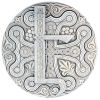In accordance with the Russo-Ottoman Treaty signed in Constantinople on June 12, 1724, Eastern Armenia and Eastern Georgia were acknowledged as inseparable regions of the Ottoman Empire. At the same time, the Russians persistently advised the Armenians of Artsakh to continue their fight against the Turks, hiding the details of the Treaty of Constantinople and promising early supply of armament.
March 1729 an Armenian military delegation arrived at the Russian army’s headquarters to receive the promised armament. Russian commanders not only broke their word but also disallowed prominent commanders of Artsakh to return to their homeland.
September 2, 1804. A Russian detachment under the command of general Tsitsianov plundered the Mother See of Holy Etchmiadzin. In April 1805, the Russian army under the command of major general Nesvetayev once more pillaged the Mother See.
October 1, 1827. General Paskevich, who had with the help of Armenians fought off the Erivan Fortress from the Persians, undertook persecutions of the Armenian intelligentsia, in particular, Nerses Ashtaraketsi, a Catholicos of the Armenian Church and one of those who contributed to the creation of Armenian volunteer units within the Russian army.
1828 – 1829. During the Russo-Turkish War, Russians pillaged Western Armenian territories inhabited by Armenians. On March 11, 1836, Russian Emperor Nicholas I restricted the rights of the Armenian Church.
April 10, 1840. The Armenian Oblast established on March 21, 1828, was dismissed by the order of Nicholas I.
According to the annual report of the governor of Erivan to the Russian Empire’s government, most of the Armenian religious schools weren’t able to enlighten their students enough, so it would be unreasonable to rely on private schools.
1885, 1897, 1903. Armenian schools were shut down, and the Russian Empire commenced their policy of assimilation.
The 1890s. The Russian Empire strongly supported Abdul Hamid during the Armenian massacres.
In accordance with a special order of the Tsar, the Armenian Church was deprived of 230 Armenian primary schools, which would fall under the jurisdiction of the Russian Empire. Only the Law of God and grammar were allowed to be taught in Armenian. The number of sessions of those subjects would be also cut down, which meant the annihilation of primary schools.
June 12, 1903. Nicholas II ordered to confiscate the property of the Armenian Church.
1905 – 1906. The Russian government organized Tataro-Armenian clashes and massacres in the Transcaucasia.
• The trial of a representative of the Armenian intelligentsia in Saint Petersburg.
1914 – 1916. Deliberately slow advancement of Russian troops in the Caucasian front, as well as sudden retreats, as a result of which the Young Turks were able to carry out the Armenian Genocide in Western Armenia.
March 3, 1918. Signature of the Treaty of Brest-Litovsk between Soviet Russia and Germany, Austria-Hungary, the Ottoman Empire, and Bulgaria. A separate Russo-Turkish agreement acknowledged Western Armenia as a part of the Ottoman Empire.
May 1920. Occupation of Artsakh by the 11th Red Army and Azerbaijani military detachments.
June – August 1920. Occupation of Zangezur and Nakhichevan by the 11th Red Army and Azerbaijani detachments.
August 2, 1920. Execution of members of the Armenian parliament by the Bolsheviks: 12 members of the Dashnaktsutyun Party, as well as Arshak Shirinyan and Vahan Khoreni were shot in a prison in Goris.
August 24, 1920. In accordance with the Russo-Turkish “hearty and sincere” agreement, Western Armenia and parts of Eastern Armenia were acknowledged as inseparable regions of the Republic of Turkey. Soviet Russia also provided the Turks with armament.
September 1 – 8, 1920. The Congress of the Peoples of the East was held in Baku by the order of Lenin. Enver-pasha was a delegate at the meeting, which caused discontent among the European communists and socialists invited to the Congress. The “sacred war” against imperialism was announced at the congress. Tortured and on the verge of a breakdown, the First Republic of Armenia was presented as a country of Dashnaks-imperialists who clearly had imperialistic plans against Azerbaijan and Russia, the opponents of imperialism.
September 23, 1920. At the instigation of the Bolsheviks, the Turkish army attacked the First Republic of Armenia, starting the Armenian-Turkish War.
November 29, 1920. The Red Army invaded Armenia and proclaimed it a Soviet republic on behalf of a nonexistent worker-peasant uprising.
December 2, 1920. Sovietization of Armenia in accordance with the Treaty of Yerevan. The fall of the First Republic of Armenia.
December 1920 – February 1921. Expulsion of the Armenian intelligentsia and the commanders of the Armenian army. Pillage of the property of the Armenian population.
July 5, 1921. By the decree of Kavbiuro, Artsakh was passed to Azerbaijan.
March 16 and October 13, 1921. In accordance with the Treaty of Kars, Kars and Surmalinsky Uyezd were passed to Turkey, while Sharur-Nakhichevan was passed to Azerbaijan.
1921 – 1953. Tens of thousands of Armenians were tortured, killed, and exiled from Armenia. The Armenian intelligentsia was also hunted down.
• Kremlin forbid the Armenian Church to carry out services in the memory of the victims of the 1915 Armenian Genocide.
• Catholicos of all Armenians Khoren I (Aleksandr Muradbekian) was strangled in Etchmiadzin.
May 30, 1953. The government of the USSR declared that they had no territorial claims to Turkey.
1966 – 1988. A new wave of oppression of dissidents. The members of the underground Armenian National United Party were arrested, exiled, or killed.
February 27 – 28 1988. A new genocide of Armenians in Sumgait, Azerbaijani SSR. Soviet troops arrived “3 days late”.
January 1990. Armenian pogroms in Baku. Soviet troops again arrived “7 days late”.
April – May 1991. Russo-Azerbaijani Operation Ring. Pogroms of Armenians in Artsakh.
Since 1991. Reinforced arming of Azerbaijan by Russia, including weapons of mass destruction.
Arshaluys Zurabyan
Read also: Plunder of the Armenian Apostolic Church by the Decree of Russian Tsar Nicholas II – 1903, The Plundering of the Mother See of Holy Etchmiadzin by Russian Troops – 1804 – 1805

